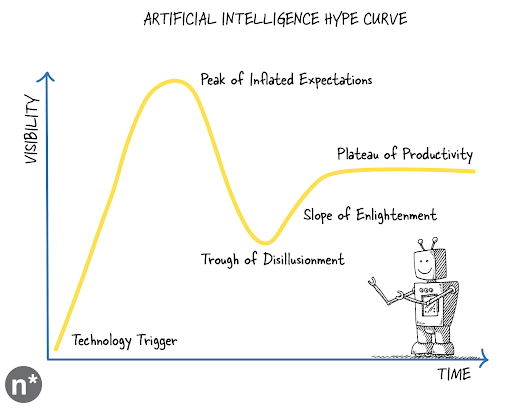As the pace of technological innovation continues to accelerate, there's no shortage of exciting new tools and platforms that promise to transform the way we work and live. From AI-powered chatbots like ChatGPT to immersive storytelling platforms like Bard and MidJourney, to voice-activated assistants like Alexa and Google Home, there's no denying the potential for these tools to revolutionise industries and create new opportunities for growth and innovation. However, as with any new technology, it's important to approach these tools with a critical eye and a clear understanding of their capabilities and limitations. At nordstar*, we're committed to helping businesses navigate the hype and identify where these new tools can make a real impact on their operations.
You’ve probably noticed how every new technology is touted as the solution to all our problems? From artificial intelligence (AI) to virtual reality (VR) to voice activated tools , the hype is real. But is it justified? We sometimes think not. We warn our partners against getting caught up in the hype and encourage them to be mindful of a technology's limitations.
The hype cycle, also known as the technology adoption lifecycle, illustrates the journey that new technologies typically go through. The cycle has five phases: the innovation trigger, the peak of inflated expectations, the trough of disillusionment, the slope of enlightenment, and the plateau of productivity.

Let's take VR as an example. When it was introduced in the early 2010s, everyone was excited about the possibilities. Experts predicted that it would revolutionise entertainment, education, and social interaction. But as time passed, it became clear that VR had significant limitations, such as its high cost, clunky hardware, and lack of compelling content. The hype died down, and many people thought it would never achieve mainstream adoption. However as it has become more mature as a technology we have seen many clients and sectors now start to adopt VR successfully, it has been used in healthcare to assist patients with chronic pain and mental health issues. It has also been used to train medical professionals, enabling them to practice complex procedures in a realistic and safe environment, enahcning patient outcomes and reducing risks in healthcare providers.
Another example is Google Glass, a wearable technology that promised to revolutionise how we interact with the world. Despite initial excitement and hype, it failed to live up to expectations. One reason for its failure was its high cost, which made it inaccessible to many potential users. Additionally, privacy concerns were raised, as it had the potential to record people without their consent. These issues led to the eventual discontinuation of Google Glass.
More recently, there has been a lot of hype around blockchain technology, often associated with cryptocurrencies like Bitcoin. While blockchain has the potential to revolutionise many industries, such as finance and supply chain management, it's important to recognize that it's not a cure-all. In many cases, more traditional methods may be more efficient and effective. Also, there are significant technical and regulatory challenges that need to be addressed before blockchain can achieve widespread adoption.
While new technologies like AI, VR, and blockchain hold significant promise, it's crucial to approach them with caution and realism. We should view them as tools to be used where they can make a meaningful contribution, rather than as a silver bullet for all our problems. By doing so, we can harness their potential in a way that is responsible, effective, and fair, and avoid the pitfalls of the hype cycle.
It's easy to get caught up in the hype of new and trendy technologies. But just because something is cool or innovative doesn't necessarily mean it's the right solution for your business. It's important to be clear on the outcomes you're looking to achieve and the problems you're trying to solve before investing in any new technology. By taking the time to carefully assess your business needs and match them with the right technology, you'll be much more likely to achieve the results you're looking for.
As technology continues to evolve at breakneck speed, there are all sorts of cool and exciting new tools popping up - from AI chatbots like ChatGPT to immersive storytelling platforms like Bard and MidJourney, and even voice-activated assistants like Alexa and Google Home. It's easy to get swept up in the hype and want to try out everything just because it's new and shiny. But before you invest in any new tech, it's important to take a step back and ask yourself: what problems am I trying to solve? What outcomes do I want to achieve? After all, as the old saying goes, to a hammer everything is a nail - tool selection is key. At nordstar*, we believe in taking a strategic approach to technology adoption, focusing on business outcomes first and foremost.
All that said, we're not suggesting that AI isn't worth the hype, there are certainly benefits to using AI as an assistant or to generate new ideas. AI-powered tools can help identify patterns and insights that humans may not have recognised, providing new starting points for ideation and problem-solving. By automating repetitive or mundane tasks can also AI free up valuable time for employees to focus on more interesting and high-value work. At nordstar*, we're very excited about the potential for AI to augment human capabilities and help our clients achieve their goals more efficiently and effectively.
If you're unsure about how to best leverage new technologies such as AI, why not consider partnering with nordstar*? With our expertise in technology strategy and innovation, we can help you identify where new technologies can make a real impact on your business and where they may not be the best fit. Our approach is grounded in realism and practicality, so you can be sure that our recommendations will be both effective and achievable. Don't let the hype cycle fool you into thinking that new technologies are the answer to all your problems but with our support, you can harness the potential of these technologies in a way that is responsible, effective, and fair.
Get in touch with our team at nordstar* today and see how we can help you navigate the ever-changing world of technology?
Neil
Managing Partner
Contact the team to see how we can help you - here


